Albanian lek facts for kids
Quick facts for kids Albanian lek |
|||||
|---|---|---|---|---|---|
|
|||||
| ISO 4217 Code | ALL | ||||
| User(s) | |||||
| Inflation | 2.6% | ||||
| Source | [1] 2024 | ||||
| Subunit | |||||
| 1⁄100 | qindarkë | ||||
| Symbol | L | ||||
| Plural | lekë | ||||
| qindarkë | qindarka | ||||
| Coins | |||||
| Freq. used | 5 Lekë, 10 Lekë, 20 Lekë, 50 Lekë, 100 Lekë | ||||
| Rarely used | 1 Lek, 50 Lekë (2003 series) | ||||
| Banknotes | |||||
| Freq. used | 200 Lekë, 500 Lekë, 1,000 Lekë, 2,000 Lekë, 5,000 Lekë | ||||
| Rarely used | 10,000 Lekë | ||||
The lek (called leku shqiptar in Albanian) is the official money of Albania. Its symbol is L, and its code is ALL. One lek used to be divided into 100 qindars (called qindarka).
History of the Lek
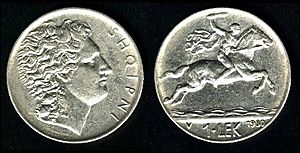
The lek became Albania's first official money in February 1926.
Money Before the Lek
Before 1926, Albania did not have its own currency. People used different foreign coins, like the Ottoman Turkish piastre. During World War I, some people used paper money from Austria-Hungary. However, many Albanians still preferred to use gold and silver coins. Some even traded goods directly, which is called barter.
In 1923, Italian paper money was used in some cities. Greek money, called the drachma, was used in other areas. The value of these foreign currencies changed a lot from place to place.
The Gold Standard
From 1926 to 1939, the Albanian lek was linked to the gold standard. This meant that lek banknotes could be exchanged for a certain amount of gold. Because of this, the lek stayed quite stable and did not lose much value.
However, after Italy took over Albania, the country's gold reserves were taken. This, along with the introduction of the Italian lira in Albania, caused the lek to lose a lot of its value.
Where the Name Comes From
The name lek comes from Alexander the Great. In Albanian, his name is often shortened to Leka. You can even see Alexander's picture on the front of the 1 lek coin. The back of the coin shows him riding his horse.
The word qindarkë comes from the Albanian word qind, which means one hundred. This is similar to how the word "cent" means one hundredth of a dollar.
The Franga Ari
Between 1926 and 1939, there was another important unit of Albanian money called the franga ari (meaning gold franc). One franga ari was worth 5 lek. It was mainly used for international trade.
Coins
Early Lek Coins
In 1926, Albania started making coins. They made bronze coins for 5 and 10 qintars. They also made nickel coins for 1⁄4 Lek, 1⁄2 Lek, and 1 Lek. Silver coins were made for 1, 2, and 5 franga ari. The franga coins showed King Zog.
Later, in 1935, new bronze coins were made. These coins had beautiful designs inspired by ancient art.
When Italy took over Albania in 1939, new coins were made. These included stainless steel coins for 0.20, 0.50, 1, and 2 lek. Silver coins were made for 5 and 10 lek. These coins showed the Italian King Victor Emmanuel III.
After the Communist Party came to power in 1947, older coins were removed. New zinc coins were introduced for 1⁄2 Lek, 1 Lek, 2 Lek, and 5 Lek. These coins featured the country's socialist symbol.
The Second Lek (1965-1991)
In 1965, Albania changed its money system. Old money was exchanged for new money at a rate of 10 old lek for 1 new lek.
New aluminum coins were made for 5, 10, 20, and 50 qintars, and 1 Lek. All these coins showed the socialist state symbol. In 1969, a second series of coins was released to celebrate Albania's liberation from fascism in 1944.
In 1988, the coins were redesigned again. The 50 qindarka and 1 Lek coins looked too similar. So, new 1 Lek coins made of aluminum-bronze were released to make them easier to tell apart. In 1989, a 2 Lek coin was added.
These coins were used until 1992. After that, qintars were no longer used.
Foreign Exchange Certificates
Like some other socialist countries, Albania used special money called foreign exchange certificates. You could only use these in certain shops. It was not allowed to exchange them for regular lek banknotes.
The Third Lek (1995-Present)
In 1995 and 1996, new coins were introduced. These included 1 Lek, 5 Lekë, 10 Lekë, 20 Lekë, and 50 Lekë. A special 100 Lekë coin, made of two different metals, was added in 2000.
| Coins of the lek (1995–present) | |||||||||||
|---|---|---|---|---|---|---|---|---|---|---|---|
| Image | Value | Technical parameters | Description | Dates | |||||||
| Obverse | Reverse | Diameter | Thickness | Mass | Composition | Edge | Obverse | Reverse | Year of minting | Year of issue | |
| 1 Lek | 18.1 mm | 1.6 mm | 3 g | Bronze (1996), Copper-plated Steel (2008-2013) | Smooth | A pelican in the centre, "Republika e Shqipërisë", year |
Nominal value, branches artistically carved in the form of a crown |
1996, 2008, 2013 | 1996 | ||
 |
 |
5 Lekë | 20 mm | 1.6 mm | 3.12 g | Nickel-plated Steel | Eagle from the Flag of Albania, "Republika e Shqipërisë", year |
1995, 2000, 2011, 2014, 2020 | 1995 | ||
 |
 |
10 Lekë | 21.25 mm | 1.5 mm | 3.6 g | Aluminum-bronze (1996-2000), Brass-plated Steel (2009-2018) | Milled | Berat Castle, "Republika e Shqipërisë", year | 1996, 2000, 2009, 2013, 2018 | 1996 | |
 |
 |
20 Lekë | 23 mm | 2 mm | 4.6 g | Aluminum-bronze (1996-2000), Brass-plated Steel (2012-2020) | A Liburne ship, "Republika e Shqipërisë", year | 1996, 2000, 2012, 2016, 2020 | 1996 | ||
 |
 |
50 Lekë | 24.25 mm | 1.5 mm | 5.5 g | Copper-nickel | Portrait of the Illyrian King Gentius, Republika e Shqipërisë", year |
1996, 2000, 2020 | 1996 | ||
 |
 |
50 Lekë | 24.25 mm | 5.5 g | Copper-nickel | An Illyrian helmet, "Republika e Shqipërisë", "Antikiteti Shqiptar", year | Nominal value, divided by a horizontal line and in the arch above "Antikiteti Shqiptar" | 2003 | 2004 | ||
 |
 |
100 Lekë | 24.75 mm | 1.9 mm | 6.7 g | Bi-Metallic: Aluminium-bronze centre in Copper-nickel ring | Portrait of the Illyrian Queen Teuta, "Republika e Shqipërisë", year | Nominal value, branches artistically carved in the form of a crown |
2000 | 2000 | |
| These images are to scale at 2.5 pixels per millimetre. For table standards, see the coin specification table. | |||||||||||
Commemorative Coins
Albania also makes special coins to celebrate important events.
- In 2001, coins were made for Albania joining the European Union.
- Other coins celebrated the 500th anniversary of the Statue of David.
- In 2002, coins marked 90 years since Albania declared its independence.
- Coins have also featured themes like "Albanian Antiquity" and traditional costumes.
Banknotes
First Lek Banknotes
In 1926, the National Bank of Albania started printing banknotes. These were in values of 1, 5, 20, and 100 franga ari. More notes were issued in 1939 and 1944.
In 1945, the People's Bank of Albania took over. They printed new notes for 10, 50, 100, 500, and 1000 lek. In 1947, the franga-ari was no longer used, and the lek became the main currency.
| 1947 series | |||||||||||||||||||||||||||||||||||||||||||||
|---|---|---|---|---|---|---|---|---|---|---|---|---|---|---|---|---|---|---|---|---|---|---|---|---|---|---|---|---|---|---|---|---|---|---|---|---|---|---|---|---|---|---|---|---|---|
| Obverse | Reverse | Value | |||||||||||||||||||||||||||||||||||||||||||
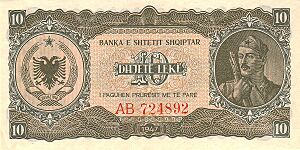 |
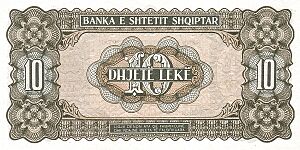 |
10 Lek | |||||||||||||||||||||||||||||||||||||||||||
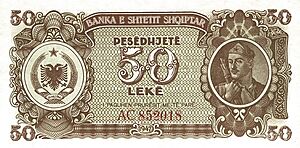 |
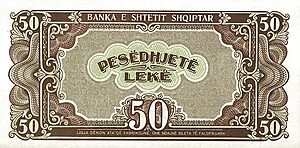 |
50 Lek | |||||||||||||||||||||||||||||||||||||||||||
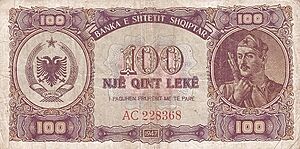 |
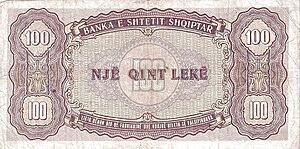 |
100 Lek | |||||||||||||||||||||||||||||||||||||||||||
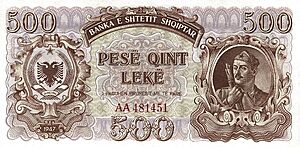 |
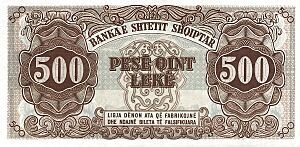 |
500 lekë | |||||||||||||||||||||||||||||||||||||||||||
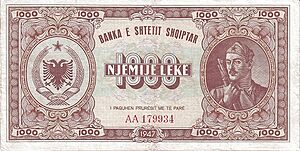 |
 |
1,000 Lek | |||||||||||||||||||||||||||||||||||||||||||
| 1949 and 1957 series | |||||||||||||||||||||||||||||||||||||||||||||
| Obverse | Reverse | Value | |||||||||||||||||||||||||||||||||||||||||||
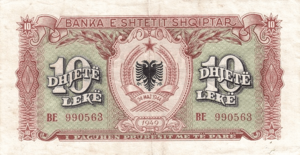 |
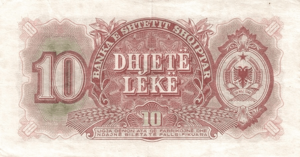 |
10 Lek | |||||||||||||||||||||||||||||||||||||||||||
 |
 |
50 Lek | |||||||||||||||||||||||||||||||||||||||||||
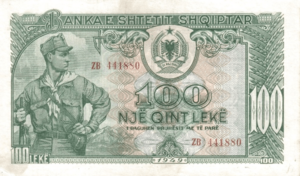 |
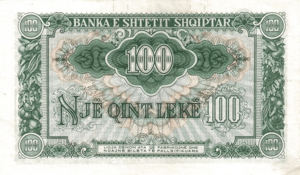 |
100 Lek | |||||||||||||||||||||||||||||||||||||||||||
 |
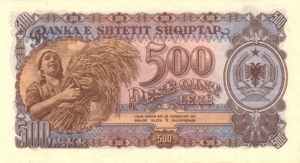 |
500 Lek | |||||||||||||||||||||||||||||||||||||||||||
 |
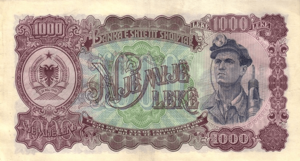 |
1,000 Lek | |||||||||||||||||||||||||||||||||||||||||||
Second Lek Banknotes
In 1965, new banknotes were introduced. These included values like 1, 3, 5, 10, 25, 50, and 100 lek. A second series of these notes came out in 1976. This was when the country changed its name to the People's Socialist Republic.
| 1964 and 1976 series | |||||
|---|---|---|---|---|---|
| Obverse | Reverse | Value | Colour | Obverse | Reverse |
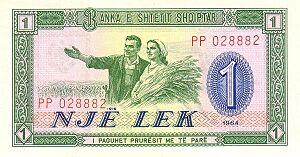 |
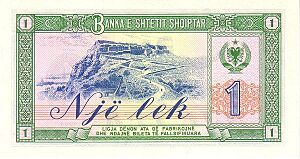 |
1 Lek | Green | Peasant couple with wheat | Rozafa Castle, Shkodër |
 |
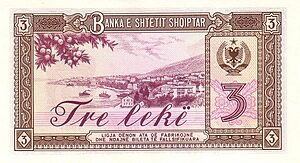 |
3 Lek | Brown | Woman carrying basket of fruit | Vlora |
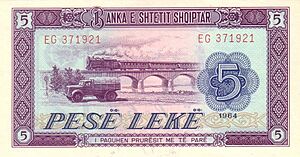 |
 |
5 Lek | Purple | Steam train and truck | Ship |
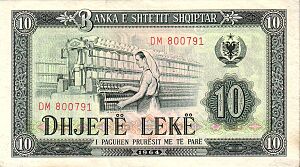 |
 |
10 Lek | Green | Woman working in a textile mill | Bureaucrats and peasants socializing outside the Palace of Culture, Naim Frashëri |
 |
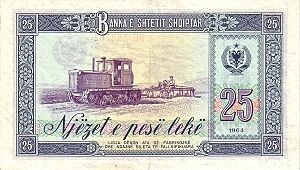 |
25 Lek | Dark blue | Woman with wheat, combine harvesting | Mechanized ploughing |
 |
 |
50 Lek | Red | Army on parade, Skanderbeg | Mosin–Nagant rifle, pickaxe, apartment block under construction |
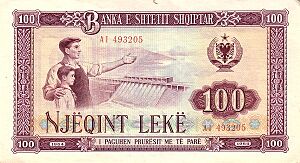 |
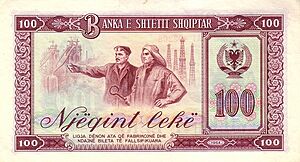 |
100 Lek | Scarlet | Man showing his son a new hydroelectric dam | Steelworker with oil worker, gesturing grandly, steelworks and oil wells in background |
| 1991 Series | |||||
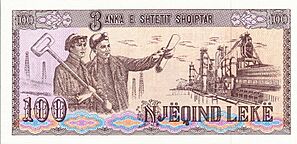 |
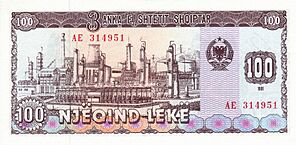 |
100 Lek | purple | Steelworkers in front of a factory | factory |
 |
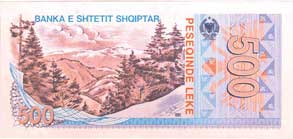 |
500 Lek | blue, orange | Woman with sunflowers, denonimation ornament | Mountain landscae |
1992 Series
In 1992, special banknotes called "foreign currency leks" (Lek Valutë) were issued. These were for 10 and 50 foreign currency leks. Their value was much higher than regular leks. For example, 10 foreign currency leks were worth 500 regular leks. These notes were only used for one year.
| 1992 Series | ||||||
|---|---|---|---|---|---|---|
| Image | Value | Dimensions | Main Colour | Description | ||
| Obverse | Reverse | Obverse | Reverse | |||
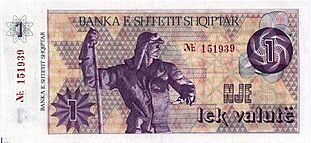 |
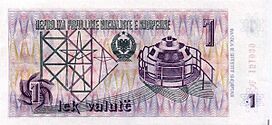 |
1 Lek | 165×75 | Violet | Steel worker | Electrical transmission towers, hydroelectric generator |
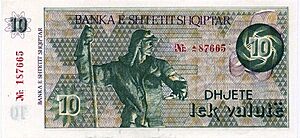 |
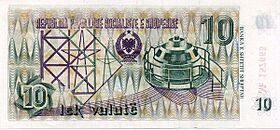 |
10 Lek | Green | |||
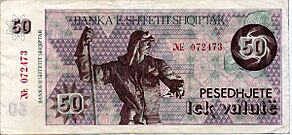 |
 |
50 Lek | Brown | |||
 |
 |
100 Lek | 154 × 72 mm | Violet | National fighter | Falcon and mountains |
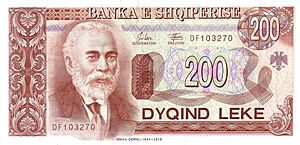 |
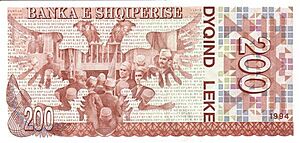 |
200 Lek | 162 × 78 mm | Brown | Ismail Qemali | Coat of arms of Albania, declaration of independence of Albania |
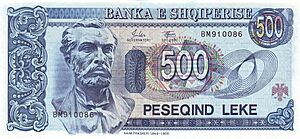 |
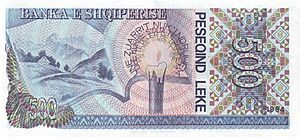 |
500 Lek | 170 × 78 mm | Blue | Naim Frashëri | Poetry of Frashëri |
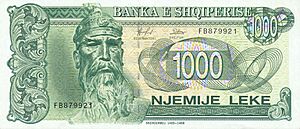 |
 |
1,000 Lek | 178 × 78 mm | Green | Skanderbeg | Krujë Castle |
1997 Series
On July 11, 1997, a new series of banknotes was introduced. These notes had improved security features. The 2000 lek note was added in 2008.
| 1996 Series | ||||||
|---|---|---|---|---|---|---|
| Image | Value | Dimensions | Main Colour | Description | ||
| Obverse | Reverse | Obverse | Reverse | |||
 |
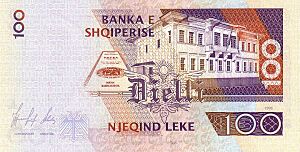 |
100 Lek | 130 × 66 mm | Purple/Orange | Fan S. Noli (1882–1965) | First Albanian Parliament building |
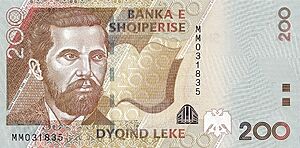 |
 |
200 Lek | 138 × 69mm | Brown | Naim Frashëri (1846–1900) | House birthplace of Frashëri |
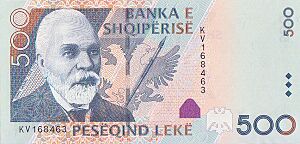 |
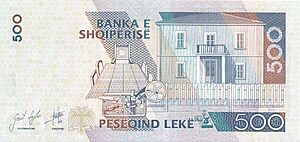 |
500 Lek | 145 × 68 mm | Blue | Ismail Qemali (1844–1919) | Vlorë independence building |
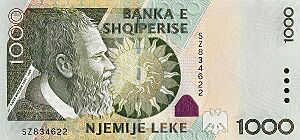 |
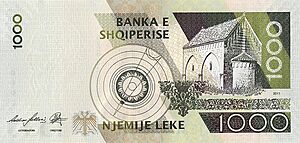 |
1,000 Lek | 151 × 72 mm | Green | Pjetër Bogdani (1630–1689) | Gothic Church of Vau |
 |
 |
2,000 Lek | 160 x 72 mm | Purple | King Gent (Gentius) (181 BC–168 BC); three ancient coins | Amphitheatre at Butrinto (near Saranda), yellow gentian (Gentiana lutea) |
 |
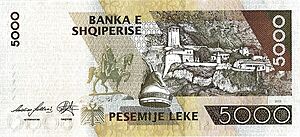 |
5,000 Lek | 160 × 72 mm | Olive Green | Skanderbeg (1405–1468) | Krujë Castle |
2019–2022 Series
In 2019, the Bank of Albania introduced a new series of banknotes. These notes have the same themes as the 1997 series. However, they have better security features. The 200 Lek banknote is now made of a special plastic material called polymer banknote.
This new series also includes a 10,000 Lek banknote. This is the highest value banknote ever issued for general use in Albania. The first new notes (200 and 5,000 lekë) came out in September 2019. The 1,000 Lek and 10,000 Lek notes were released in June 2021. The 2,000 Lek and 500 Lek notes followed in January 2022.
| 2019–2022 series | ||||||
|---|---|---|---|---|---|---|
| Image | Value | Dimensions | Main Colour | Description | ||
| Obverse | Reverse | Obverse | Reverse | |||
 |
 |
200 Lek | 125 mm x 65 mm | Brown | Naim Frashëri | House birthplace of Frashëri, paper with a famous verse from one of Frashëri's poems |
 |
 |
500 Lek | 132 mm x 69 mm | Blue | Ismail Qemali | Vlorë independence building, the telegraph which was used to announce the country's independence, and the room where the decision was made |
 |
 |
1,000 Lek | 139 mm x 69 mm | Green | Pjetër Bogdani | Gothic Church of Vau |
 |
 |
2,000 Lek | 146 mm x 72 mm | Purple | King Gent (Gentius); three ancient coins | Amphitheatre at Butrint (near Saranda), yellow gentian (Gentiana lutea) |
 |
 |
5,000 Lek | 153 mm x 72 mm | Yellow | Skanderbeg | Krujë Castle, Skanderbeg's monument in Tirana's Skanderbeg Square, and his helmet |
 |
 |
10,000 Lek | 160 mm x 72 mm | Orange | Asdreni (1872–1947) | Figurative symbols of national flag, first two lines from the national anthem |
Exchange rates
| Current ALL exchange rates | |
|---|---|
| From Google Finance: | AUD CAD CHF EUR GBP HKD JPY USD |
| From Yahoo! Finance: | AUD CAD CHF EUR GBP HKD JPY USD |
| From XE.com: | AUD CAD CHF EUR GBP HKD JPY USD |
| From OANDA: | AUD CAD CHF EUR GBP HKD JPY USD |
| From fxtop.com: | AUD CAD CHF EUR GBP HKD JPY USD |
See Also
 In Spanish: Lek albanés para niños
In Spanish: Lek albanés para niños
- Franga
- Korçë frange
- Economy of Albania



